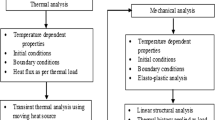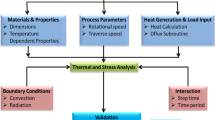Abstract
Aluminum alloys such as AA2124 and AA7075 are widely used in aeroplane construction. Certain applications of aircraft manufacturing need dissimilar joint of the aforementioned aluminum alloys. The investigation involves predicting residual stresses in multiple directions (X, Y, and Z) along the transverse direction of welding in butt-welds using ANSYS APDL. Simulated stresses which are tensile along weld bead are well concurrent with the XRD experimental findings (Gas Turbine Research Establishment). During TIG welding of these plates different currents were used to form dissimilar joints and all of them form visible cracks along the weld bead. This formation of cracks is well accord with both simulated and experimental tensile residual stresses. The simulated stresses are compared to the numerical values i.e., experimental findings, and the discrepancy of less than 10% has been noticed. Thus, simulated model can be used as tool for prediction of cracks for joining dissimilar aluminum alloys of above said.



















Similar content being viewed by others
References
Zhang, W.Y., Jiang, W.C., Zhao, X., Tu, S.T.: Fatigue life of a dissimilar welded joint considering the weld residual stress: experimental and finite element simulation. Int J Fatigue 109, 182–190 (2018)
Taban, E., Gould, J.E., Lippold, J.C.: Dissimilar friction welding of 6061–T6 aluminum and AISI 1018 steel: properties and micro structural characterization, (Materials & Design). Elsevier, Armsterdam (2010)
HuseyinUzun, C.D., Donne, A.A., TommasoGhidini, C.G.: Friction stir welding of dissimilar Al 6013–T4 To X5CrNi18-10 stainless steel. Mater. Des. 26, 41–46 (2005)
Aliha, M.R.M., Gharehbaghi, H.: The effects of combined mechanical load/welding residual stress on mixed mode fracture parameters of a thin aluminum cracked cylinder. EngFractMech 180, 213–228 (2017)
Lu, Y., Zhu, S., Zhao, Z., Chen, T., Zeng, J.: Numerical simulation of residual stresses in aluminum alloy welded joints. J. Manuf. Process. 50, 380–393 (2020). https://doi.org/10.1016/j.jmapro.2019.12.056
Zhao, L., Liang, J., Zhong, Q., Yang, C., Sun, B., Du, J.: Numerical simulation on the effect of welding parameters on welding residual stresses in T92/S30432 dissimilar welded pipe. Adv Eng Software 68, 70e9 (2014)
Costa, S., Souza, M.S., Cesar, M.B., Goncalves, J., Ribeiro, J.E.: Experimental and numerical study to minimize the residual stresses in welding of 6082–T6 aluminum alloy. AIMS Mater Sci 8, 271e82 (2021)
Farhang, M., Sam-Daliri, O., Farahani, M., Vatani, A.: Effect of friction stir welding parameters on the residual stress distribution of Al-2024-T6 alloy. J Mech Eng Sci 15, 768494 (2021)
Ji, S.D., Fang, H.Y., Liu, X.S., Meng, Q.G.: Influence of a welding sequence on the welding residual stress of a thick plate. Model Simulat Mater Sci Eng 13, 553e65 (2005)
Hammad, A., Churiaque, C., Sanchez-Amaya, J.M., Abdel- Nasser, Y.: Experimental and numerical investigation of hybrid laser arc welding process and the influence of welding sequence on the manufacture of stiffened flat panels. J Manuf Process 61, 527e38 (2021)
Trupiano, S., Belardi, V.G., Fanelli, P., Gaetani, L., Vivio, F.: A novel modeling approach for multi-passes butt-welded plates. J Therm Stresses 44, 1e21 (2021)
Okano, S., Tanaka, M., Mochizuki, M.: Arc physics-based heat source modelling for numerical simulation of weld residual stress and distortion. Sci Technol Weld Join 16, 209e14 (2011)
Liu, Z.H., Xiu, L., Wu, J.F., Lv, G., Ma, J.G.: Numerical simulation on residual stress eliminated by shot peening using SPH method. Fusion Eng Des 147, 111231 (2019)
Mo, T., Chen, J., Zhang, P., Bai, W., Mu, X., Wu, Y.: Numerical simulation of the effect of ultrasonic impact treatment on welding residual stress. Int J Mod Phys B 35, 2150175 (2021)
Cho, J.R., Lee, B.Y., Moon, Y.H., Van Tyne, C.J.: Investigation of residual stress and post weld heat treatment of multi-pass welds by finite element method and experiments. J Mater Process Technol 155e156, 1690e5 (2004)
Yang, Y.-P.: Recent advances in the prediction of weld residual stress and distortion - Part 1. Weld J 100, 15170 (2021)
Mochizuki, M., Hayashi, M., Hattori, T.: Numerical analysis of welding residual stress and its verification using neutron diffraction measurement. J Eng Mater Technol 122, 98–103 (2000). https://doi.org/10.1115/1.482772
Chujutalli, J., Lourenço, M.I., Estefen, S.: Methodology for the determination of heat source parameters for a FCAW process (2016)
Eswara, V., Jaggannadha, Rao, D. V. N. J., Seetharama, Rao, Y.: Finite element simulation of residual stresses in welded steel butt joints and their experimental verification and mitigation. In IOP conference series: materials science and engineering (2020)
Yelamasetti, B., Rajyalakshmi, G.: Thermal fields and residual stresses analysis in TIG weldments of SS 316 and Monel 400 by numerical simulation and experimentation. Mater Res Expr (2019). https://doi.org/10.1088/2053-1591/ab23cf
Wen, Z., Huanhuan, L., Qing, W.: Simulation of residual stress in aluminum alloy welding seam based on computer numerical simulation. Optik. 258, 168785 (2022). https://doi.org/10.1016/j.ijleo.2022.168785
Zhu, J., Chen, W., Xie, H.M.: Simulation of residual stresses and their effects on thermal barrier coating systems using finite element method. Sci. China Phys., Mech. Astron. 58, 1–10 (2014). https://doi.org/10.1007/s11433-014-5541-y
Esmaily, M., NooshinMortazavi, S., Todehfalah, P., Rashidi, M.: Microstructural characterization and formation of ά martensite phase in Ti–6Al–4V alloy butt joints produced by friction stir and gas tungsten arc welding processes. Mater Des 47, 143–150 (2013)
Goldak, J., Chakravarti, A., Bibby, M.: A new finite element model for welding heat sources. Metall Trans B 15(2), 299–305 (1984)
Biswas, P., Mahapatra, M.M., Mandal, N.R.: Numerical and experi-mental study on prediction of thermal history and residual defor-mation of double-sided fillet welding. J Eng Manuf Proc Inst Mech Eng 224(Part B), 125–134 (2009)
Reda, R., Magdy, M., Rady, M.: Ti–6Al–4V TIG weld analysis using FEM simulation and experimental characterization. Iran. J. Sci. Technol., Trans. Mech. Eng. 44, 1–18 (2019). https://doi.org/10.1007/s40997-019-00287-y
Wen, Q., Li, W., Wang, W.B., Wang, F., Gao, Y.J., Patel, V.: Experimental and numerical investigations of bonding interface behavior in stationary shoulder friction stir lap welding. J Mater Sci Technol (2018). https://doi.org/10.1016/j.jmst.2018.09.028
He, M., Zhang, Z.-F., Mao, W., Li, B., Yuelong, B., Jun, X.: Numerical and experimental study on melt treatment for large-volume 7075 alloy by a modified annular electromagnetic stirring. Materials 12, 820 (2019). https://doi.org/10.3390/ma12050820
Ma, F., Fu, D., Liu, Y., Yang, D., Zhang, S., Sha, Z.: The Numerical Simulation of Temperature Field in Friction Stir Welding of 7075 Aluminium Alloy. IOP Conf. Series: Mater. Sci. Eng. 751, 012081 (2020). https://doi.org/10.1088/1757-899X/751/1/012081
Chujutalli, J., Lourenço, M.I., Estefen, S.: Methodology for the determination of heat source parameters for a FCAW process (2016)
Acknowledgements
The authors would like to thank Dr. K.V.L Raju, Principal, MVGR College of Engineering (A), Vijayaram Nagar campus, Vizianagaram, India for his continued encouragement and permission to publish this work. Authors are also grateful to the support extended by Director Gas Turbine Research Establishment for extending their valuable support.
Author information
Authors and Affiliations
Corresponding author
Additional information
Publisher's Note
Springer Nature remains neutral with regard to jurisdictional claims in published maps and institutional affiliations.
Rights and permissions
Springer Nature or its licensor (e.g. a society or other partner) holds exclusive rights to this article under a publishing agreement with the author(s) or other rightsholder(s); author self-archiving of the accepted manuscript version of this article is solely governed by the terms of such publishing agreement and applicable law.
About this article
Cite this article
Prasad, M.J.H., Sudhakar, I., Adinarayana, S. et al. Simulation and validation of experimental residual stresses of dissimilar AA2124 and AA7075 TIG weld joint using ANSYS APDL. Int J Interact Des Manuf 18, 71–82 (2024). https://doi.org/10.1007/s12008-023-01384-8
Received:
Accepted:
Published:
Issue Date:
DOI: https://doi.org/10.1007/s12008-023-01384-8




